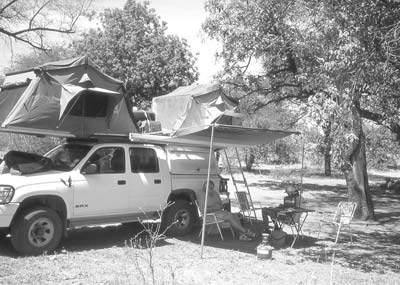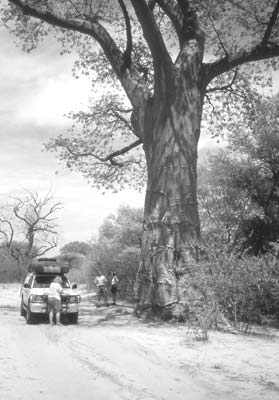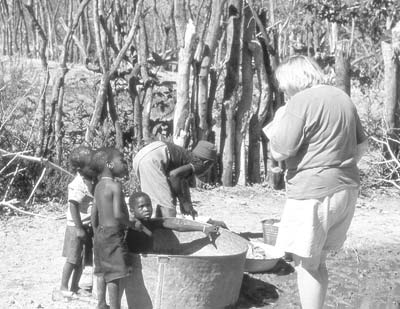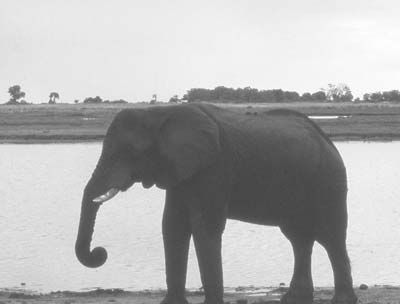Botswana self-drive safari — a truly wild ride
by Robert Juhre, Kettle Falls, WA
Travel in Botswana is limited to a few choices. You can book accommodations through one of many tour operators. Their camps are generally small, accommodating 12 to 15 people, and are remote but well appointed.
The food is gourmet, and the attention to guests’ personal care and comfort is outstanding. Visitors can see an abundance of wildlife in the immediate vicinity of most camps. However, these camps are expensive, ranging from $250 to over $500 per person per day, not including airfare or the national park entrance fees, which are also very high.
There are camps outside Chobe National Park that offer excellent day trips into the park. These are more resort-like, more accessible and less expensive.
Another way to see Botswana is to book through a safari company that will do a group tour. Or you can hire a truck and driver. We decided to do it on our own.
Starting out
The reasons for our decision to rent our vehicle in South Africa, where we would spend some time before continuing on to Botswana, were twofold. It was less expensive, and the South African Tourism Board enforces the rule that all safari rental vehicles must be taken out of service after two years or 50,000 kilometers. (We appreciated this later, based on the tremendous stress we put on our vehicle.)
The cost of a safari-equipped Toyota truck (with 4-wheel drive, two tents on a roof platform, an extra-large gas tank, extra gas jerry cans, water tank, refrigerator, complete tool kit, two spare tires and everything else needed for comfortable camping) was about $65 per day, including unlimited mileage.
So, in October ’02, my wife, Elaine, and I arrived in Johannesburg, South Africa, along with our daughter, Karen, and son-in-law, Mike. We flew Northwest/KLM, although American Airlines and South African Airways also fly from the U.S. to South Africa. We stayed at the airport hotel InterContinental Airport Sun Johannesburg (phone 27 11 961 5400, fax 27 11 961 5401 or e-mail airportsun@southernsun.com) for $90 double.
A minor obstacle
Our first destination was Kuraman, South Africa, where we provisioned for the three weeks we would be in Kgalagadi Transfrontier Park and the Central Kalahari Game Reserve. You must be self-sufficient!
We entered the park at Twee Rivieren and encountered a problem that could have cost us weeks of backtracking. There is a rule that you must have two totally self-sufficient vehicles to cross this area, and you could not exit through the Kaa Gate at the northern border without specific approval from the authorities.
Fortunately, Mike had the name of a top park official he had communicated with over the previous months. By using the official’s name and implying that he had given us verbal permission, showing the park employees our detailed GPS maps and explaining that we were experienced desert travelers, having previously crossed the Sahara Desert in a VW, they reluctantly allowed us to proceed.
October is the hottest month of the year there. Temperatures can reach 125°F, and we were informed that no one had driven the track in more than a month.
Kgalagadi Transfrontier Park
Kgalagadi Transfrontier Park conserves a wide variety of desert game, such as the hartebeest, eland, springbok, wildebeest and gemsbok. There are also some specialized animals, like the bat-eared fox, the honey badger and mongoose, and a population of predators, including the famous black-maned lion, brown hyena, leopard and cheetah. We were fortunate to see all of them, along with tortoises, a golden cobra and many of the 50 species of birds that can be found there. We avoided the black and green mambas.
This park offers breathtaking landscapes of rolling grasslands with occasional small islands of indigenous trees and shrubs. It was hot and desolate, plus it was difficult to drive on the sand tracks, but we found it absolutely fascinating.
We headed north through three small San (Bushman) villages. The San are one of the oldest peoples in South Africa. Life there is harsh to the extreme. There were no trees and no gardens, only sand and heat.
From there we connected to the Trans Kalahari Highway on our way to Maun, Botswana, the jumping-off place for visits to the Okavango Delta, Moremi Wildlife Reserve and Chobe National Park.
On to Maun
Ghanzi, a colorful frontier town built around the cattle ranching industry, was a place to restock our supplies of water, petrol and food.
In D’Kar, the next small town, the community trust provides visitors with an opportunity to experience the San people and their crafts. Their click-click manner of speaking is unique. Here we purchased necklaces made from broken ostrich shells, small Bushman bows and arrows, some simple paintings and other interesting items relating to their culture.
Our next stop was Maun, where we needed a few days of R&R. We stayed at Audi Camp (phone 267 6860 599 [offices], fax 267 6860 581 or visit www.audicamp.bizland.com), located on a river outside Maun.
The supermarket in Maun, where we purchased more groceries and beverages for the next two weeks, was as well stocked as any U.S. supermarket and much cheaper. The liquor store had liquors from around the world and a complete stock of South African wines, which we felt were equal to the best of American or French vintages.
The small restaurant at Audi Camp was a real find, serving absolutely gourmet food. Dinner cost about $5 per person, including a beer or a double gin and tonic.
After resting for a day, we began a trip to Deception Pan in the center of the Kalahari Desert. There are few places in the world where the sheer vastness can evoke such awe. The incredible sunsets alone set this place apart.
There are few visitors in this area at any time of the year, especially in October. After about six hours’ driving, we experienced a loss of power and a rough-running engine caused by a failing fuel pump. With great apprehension, we retraced our track and made it back to Rileys garage in Maun. Three days later we were on our way again.
Moremi Wildlife Reserve
You must have reservations to enter the parks in Botswana. These were very difficult to obtain due to poor communications. It took us months using fax, phone, letters and e-mail. The Department of Wildlife & National Parks’ main office (P.O. Box 31, Gaborone, Botswana; fax 267 31 23 54 or e-mail dwnp@gov.bw) is a good place to start. We found that faxes worked better than e-mail, phone or regular mail.
Moremi Wildlife Reserve, bordering the Okavango Delta, was named by the wife of Chief Moremi III in her husband’s honor. Setting aside 5,000 square kilometers of a wilderness paradise in 1963 earned the Botswanan people worldwide recognition for their vision.
The park has flood plains, water holes, open lagoons, dense mopane forests and parklands, plus an abundance of all the large African animals and many smaller game species. There are many species of birds. We positively identified over 100 and probably saw an additional 150.
There are three main camping areas besides those at the south and north entrance gates. (When we say camping area, this means there will be ablution facilities: toilet, shower and hot water warmed from solar panels.) Each had its own charm and was well protected from predators.
Close encounters
At Third Bridge Campsite, which is located on a permanent lagoon, we saw crocodiles and many aquatic birds. As soon as it was dark, around 7 p.m., we would climb on top of our truck and into the tents, as prowling lions made it uncomfortable to sit outside in our camp chairs, even with a fire glowing.
One night there was a lion kill close to our truck. There was growling and snarling all night as the lions fought over the carcass of a springbok and hyenas attempted to get their share.
The baboons also posed a problem. As soon as we opened our food box, a large male rushed from the troop screaming with mouth wide open. He leaped into the back of the truck and attempted to carry off the food box. Elaine had one arm around the box and was hitting him on the head with a frying pan — not a very wise thing to do as these animals are very powerful.
Fortunately, Mike was at the side of the truck with his whip. He is very adept with a 20-foot Australian-made whip. A few cracks over the intruder’s head and the entire troop backed off. After that, the mere sight of Mike with his whip panicked them and they would retreat.
Vervet monkeys were just as troublesome but not as threatening. They too responded to the crack of the whip.
Fourth Bridge Campsite was equally alive with predators, and again we used extreme caution when leaving the safety of the truck. Crocs and hippos inhabited the waterways and it was not safe to stand on the bridge.
Local excursion
A typical day for us started at 5:30 a.m., about a half hour before dawn. Mike would have coffee and a light breakfast ready when we awoke so we could start our game drive at early light. We would return in late morning and sit around camp, reading and resting and sometimes cautiously taking short hikes.
After an early supper, we would again game drive until dark, returning around 7 p.m. Then we would sit around a fire with a glass or two of wine and our powerful spotlight. We went to bed early if the activity became threatening.
Xakanaxa, our third campsite, is located on a lagoon where it is possible to hire a mokoro (dugout canoe) and a local guide for about $20. We entered the delta, which is not unlike the Everglades except the reeds and papyrus are higher and it abounds with wildlife. We were fortunate to see the elusive red lechwe, which lives in the shallow swamps of Botswana. It has elongated, widely splayed hooves, which allows fast flight in the watery environment.
We were pleased to see the rare sacred ibis, numerous fish eagles and countless other birds.
A fearsome sight
On our return trip along a narrow 6-foot-wide waterway, we were suddenly startled when a large hippopotamus reared out of the water, roaring and charging with its mouth wide open. The hippo is very territorial and reportedly kills more people in Africa than any other animal. It was a fearsome sight with that huge open mouth only yards away.
The guide quickly back-paddled out of harm’s way. When it became apparent we could not continue on, we abandoned the mokoro and waded through the delta to reach our starting point — a somewhat tense experience when you are not sure where you are and the swamp is home to hippos, snakes and crocodiles.
Chobe National Park
We headed north to our next destination, Chobe National Park. This park has three distinct areas. The first, Savute, a 5,000-square-kilometer marsh that is said to have the highest concentration of plains animals, including zebras, wildebeest, giraffe and antelope, is the most densely populated predator area in all of Africa. We were fortunate to see both the roan and sable antelope, magnificent animals with long, back-sweeping horns. Every night provided heart-thumping excitement.
One night, soon after crawling into our sleeping bags, a herd of 200 or more Cape buffalo stampeded through our campsite. Their thundering hooves actually shook the truck. With our large spotlight, we were able to watch as they finally swam the river next to our camp.
The lions in this area demonstrated very strange behavior, killing mature elephants and buffalo. The carnage was unbelievable. In one small area, several elephants and as many buffalo were lying dead. The elephant’s skin is too tough for even a lion to penetrate, so the carcass just lies there rotting until it is soft enough for marabou storks and vultures to tear apart.
The herds of giraffe were the largest we had ever seen, sometimes numbering in the dozens.
This area had been completely flooded in 2000 and 2001, so the tracks were not always the same as what was shown on our map. There were several small rock hills in the northern part of the park which we used as navigational points. They featured some ancient San paintings and engravings which were sophisticated in both detail and meaning.
Another distinct area in Chobe National Park is Linyati, a wooded area with beautiful river frontage and many hippos and crocs. Elephants, zebra and antelope are plentiful. The most spectacular sight occurred at dusk, when the various water birds, including egrets, storks and herons, would fly up the river in large flocks to their nesting trees with a flaming sunset in the background.
Elephant territory
Finally, Serondela is an area along the Chobe River noted for its large concentration of elephants, estimated at over 40,000. This presents one of the most controversial situations in animal conservation, for they are destroying the landscape but are not culled or hunted as in some other countries.
We were once having lunch while parked in a small opening in the forest, watching a herd of several hundred females walking to and from a water hole. There were many babies of various ages, which tended to make the herd skittish.
Although we were several hundred yards away from them, suddenly a large female broke from the herd and charged. We drove out of the forest onto a sand track with the charging elephant gaining as we went. When almost upon us, it faltered and stopped.
Another time, we were sitting around camp in the afternoon when an elephant walked rapidly toward us with a purposeful stride. We scrambled into the truck and waited as he rested his tusks on the truck hood and waved his trunk over the cab.
In this densely populated elephant area, the ablutions were like medieval fortresses. The building would be surrounded by a 15-foot-high, 20-foot-wide rampart of stone and earth. The door was a 2-foot-wide slit that you entered sideways. An elaborate solar panel system heated the water.
The Chobe River was our final destination. Although much more civilized, as it can be reached by road from Kasane, it provided a tranquil end to our trip, with boat rides and fishing for the famed tigerfish.
Parting ways
Karen and Mike departed Botswana by local bus, headed for Victoria Falls and river rafting in Zambia. We traveled east across the troubled Caprivi Strip, which separates Namibia from Angola, to Etosha National Park, Namibia. This was an exciting trip with excellent game viewing and some exposure to the culture of the local people.
The absence of mosquitoes or other bugs, the ecological diversity and the grandeur of the landscape all added to a most memorable time.
Two thousand miles of traveling through spectacular country, mostly in low gear, is not for the faint of heart, but it is the true “African experience.”
For your trip planning
During our trip, petrol sold for about $1.75 a gallon. There were various insurance programs available, but we did not need them as our own insurance or our Visa card covered us.
Use the Web to obtain car rental information, and fax to inquire about ordering “Bajanala: a Tourist Guide to Botswana,” published by the Botswana Department of Tourism (fax 267 308 675 or visit www.botswanatourism.org).
We rented our self-drive vehicle from Britz in Johannesburg (fax 27 11 396 1937 or visit www.britz.co.za), booking through Ashtons Group (fax 27 21 386 1146 or visit www.ashtonsgroup.com). Other methods of travel, such as independent travel by bus or train, backpacking or excursion buses, were just not available in Botswana.
There is an informative book by Mike Main called “Visitors’ Guide to Botswana” which gives excellent advice to self drivers.
Another interesting book is “Cry of the Kalahari” by Mark and Delia Owens, two young American researchers who spent eight years in the Kalahari studying the brown hyena.
Our park entrance fees and camping fees totaled almost $2,000 for the four of us. Botswana decided some time ago that they did not want to be like Kenya with a million tourists showing up each year. Botswana has over 17% of their land in reserves or national parks. They restrict the number and size of the lodges in those areas and make it expensive to visit. Costs of supplies such as food and beverages were reasonable.





